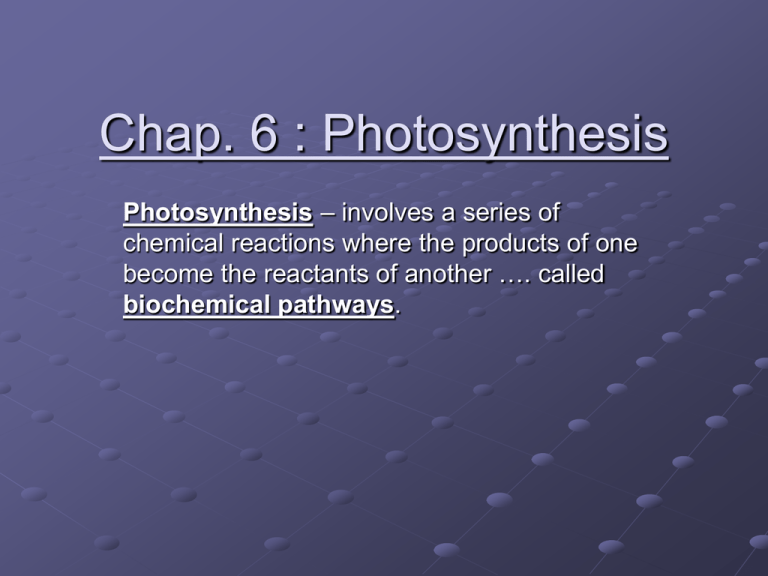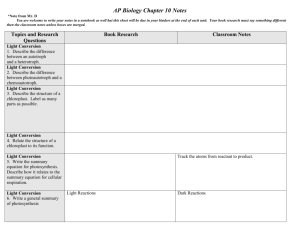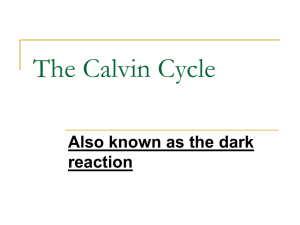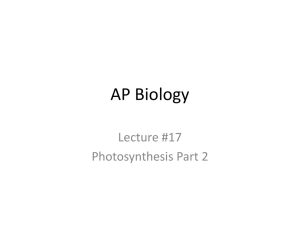Chap. 6 : Photosynthesis - Fort Thomas Independent Schools
advertisement

Chap. 6 : Photosynthesis Photosynthesis – involves a series of chemical reactions where the products of one become the reactants of another …. called biochemical pathways. I. Light Absorption (light reactions) --- occur in chloroplast A. Composition of Light ROY G BIV – each color is a certain wavelength of light. The wavelength decreases left to right. -- When light hits an object it is either : reflected, transmitted, or absorbed ( will see it) (won’t see it) Ex. Sky is blue because blue light is reflected while all others are absorbed. B. Chloroplast Pigments chlorophyll a -- main pigment chlorophyll b accessory pigments – help chlorophyll a absorb more carotenoids wavelengths of light. II. Electron Transport A. Photosystem (PS) – cluster of pigments in thylakoids. Process of Photosynthesis Electron replacement into photosystem II light water splitting molecule Photosystem II PS II 2 H2O 2H2O 4 H+ O2 4 eInside Thylakoid 4 H+ + 4e- + O2 III. Chemiosmosis -- making of ATP from creating a concentration gradient of p+( H+). Proton concentration greater inside the thylakoid than outside in stroma so this creates potential energy. This energy is used by enzyme ATP synthase molecule to change ADP to ATP --- end result of light reactions inside the thylakoids is : ATP and NADPH molecules IV. Calvin Cycle (light independent reactions)– production of organic compounds using energy stored in ATP and NADPH from the light reactions A. Steps of Calvin Cycle - CO is “fixed” – changing the carbon from CO into a carbon used by organisms (organic carbon) - occurs in the stroma of chloroplast 1. CO binds with RuBP (5-carbon sugar) to create a 6 carbon sugar which immediately splits into 2 PGA s (3-carbon molecules) 2 2 2 2. Each PGA gets an ATP and NADPH to energize PGA making it PGAL. This reduces ATP and NADPH to ADP and NADP+ which is released to go back to the light reactions. 3. 5 PGAL get more ATP added to them and are converted back to RuBP to continue the Calvin Cycle but one PGAL will be released to become the organic compound glucose. --- It takes 2 cycles through to make 1 glucose --- Plants that “fix” carbon using only the Calvin Cycle are called C plants. s 3 Calvin Cycle (Dark Reactions) Occurs in stroma of chloroplast Goes through cycle twice so end result is 1 glucose molecule (C6H12O6) *** All 3 parts together ( light dependent / chemiosmois/ and calvin cycle) NADPH and ATP form from the light reactions and provide the energy to fuel the light independent reactions (dark reactions/calvin cycle) *** Overall reaction for photosynthesis : 6CO2 + 6H2O + light → C6H12O6 + 6O2 B. Alternative Pathways -- some plants due to their environment (mostly hot and dry) cannot fix carbon like C3 plants because they would lose too much water when their stomata(pores in leaf ) opens to take in CO2 1. C4 plants – fix CO2 into a 4-carbon molecule instead of 3-carbon one. Allows stomata to open less therefore losing less water. Ex. Corn and sugar cane 2. CAM plants -- open stomata at night and collect CO2 which they then use during the day in the Calvin Cycle. Will not grow very big. Conserves water in hot tropical and desert areas. ex. Cacti and pineapple








